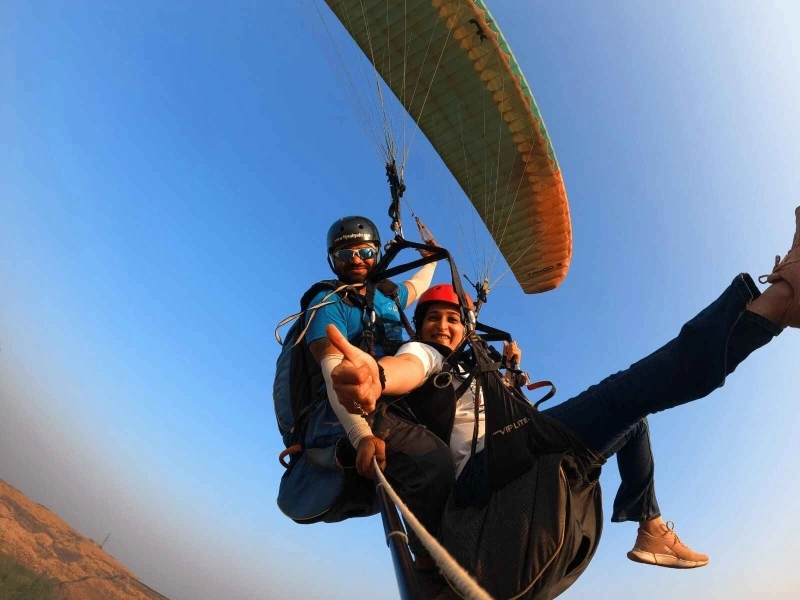Innovations in Paragliding – What's New and What's Next Trend
Discover the latest innovations in the world of paragliding and find out what's new and exciting in this thrilling sport. The Future of Paragliding For innovation technologies and trends

Paragliding, a relatively recent activity, stands out for its simplicity and the deep sense of freedom it offers. However, like all fields, paragliding too is undergoing rapid transformation, evolving significantly from its beginning, now driven by constant innovation and technological advancements.
This blog explores the emerging trends and new technologies shaping the future of this exhilarating sport.
Material Advances: Lighter, Stronger Fabrics
- 1) Materials Science: The development of lighter, stronger, and more aerodynamic fabrics has led to paragliders that are more efficient, stable, and easier to control
- 2) Revolutionary Wing Designs : New wing shapes are changing the game. They are designed to cut through the air better, which means you can glide further and more steadily. By using technology in paragliding, like computer programs that study airflow, these wings work great in many different weather conditions.
Safety Innovations:
Now, let's talk about safety, a big part of innovations in paragliding.
- 1) Smart Reserve Parachutes: Reserve parachutes are getting smart! They can figure out when they need to open on their own, making them faster and more reliable. While skydivers have used similar ideas, paragliding needs its special settings because it's a bit different.
- 2) Safety First : Innovations focusing on enhancing the safety aspects of paragliding, making it accessible to a broader audience.
- 3) Enhanced Harness Protection : Harnesses are getting better, too. They now have new kinds of foam and airbags to protect you if you land hard or run into trouble. This is part of the important technologies used by paragliders to keep you safe.
- 4) Smart Paragliders : Integration of AI and sensors to provide real-time weather and flight data, improving safety and decision-making.
Performance Tracking
- 1) Advanced Variometers: Variometers have gotten an upgrade. They're not just for measuring how fast you're going up or down anymore. Now, they come with GPS, can guess the weather, and let you share your flight info with friends as it happens. This is part of the technology in paragliding that helps you fly better and safer.
- 2) Wearable Tech Integration : Lastly, pilots can now wear smartwatches and other gadgets to keep an eye on their flight, check the weather, and even control cameras on their gear. This makes flying not just safer but a lot more fun.
Technologies Used by Paragliders: Connectivity and Efficiency
- 1) Wearable Tech: Devices like smartwatches and fitness bands monitor vital stats like heart rate, altitude, and flight path, enhancing performance and safety.
- 2) GPS Integration : Essential for navigation and flight tracking, offering precision and confidence to pilots.
- 3) Communication Tools : Advanced radio systems and satellite messengers ensure constant connectivity with other pilots and emergency services, even in remote locations, crucial for safety.
- 4) Simulation and VR : Tools providing a safe environment for training, route planning, and practice, significantly reducing the learning curve and making the sport more accessible.
Sustainability in Paragliding
- 1) Eco-friendly Materials: The shift towards biodegradable and recycled materials in paragliding gear manufacturing has reduced the sport's ecological footprint.
- 2) Hike and Fly : Promoting minimal environmental impact and promoting physical fitness by combining physical activity like hiking or mountain running with paragliding.
Community and Inclusivity: Social Aspects of Paragliding
- 1) Online Platforms: Utilizing social media for knowledge exchange, community building, and promoting safe flying practices.
- 2) Diversity Initiatives : Programs and events aimed at making paragliding more inclusive, breaking down barriers for underrepresented groups.
Conclusion
The future of paragliding is bright, fueled by continuous innovation and a growing community of enthusiasts. As technology in paragliding advances, the sport is becoming safer, more accessible, and more enjoyable. However, the heart of paragliding remains unchanged: the pure joy of flight and the connection with the natural world. By finding out new technologies and trends, the paragliding community is soaring to new heights, bringing the dream of flight within reach of more people than ever before.
Frequently Asked Questions
Q.1. What are some key innovations in paragliding?
Innovations in paragliding include lighter and stronger fabrics for the wings, the development of smart reserve parachutes that can deploy automatically based on specific flight conditions, and more. These advancements are aimed at making the sport safer and more enjoyable.
Q.2. How are technologies used by paragliders changing the experience?
Technologies used by paragliders, such as advanced variometers with GPS and weather prediction algorithms, are greatly enhancing the flying experience. These devices provide real-time data and analysis, helping pilots make informed decisions while in the air. Additionally, wearable tech like smartwatches can monitor flight data and connect with weather services, further enhancing safety and performance.
Q.3. Why is technology in paragliding important for safety?
Technology in paragliding improves the safety by providing pilots with proper equipment and tools. Innovations like better harness protection and smart reserve parachutes reduce the risk of injury during unexpected situations or rough landings. Moreover, the integration of GPS and weather prediction tools helps pilots navigate more safely and avoid hazardous conditions.
Fly Sahyadri Team
Paragliding Expert
An experienced paragliding instructor and pilot with over a decade of flying experience. Passionate about sharing knowledge and ensuring safe flying practices for all adventure enthusiasts.